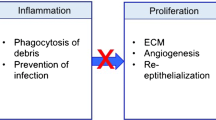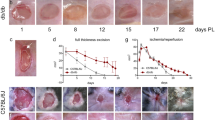Abstract
Chronic cutaneous wound (CCW) is a major health care burden wherein the healing process is slow or rather static resulting in anatomical and functional restriction of the damaged tissue. Dysregulated expression and degradation of matrix proteins, growth factors and cytokines contribute to the disrupted and uncoordinated healing process of CCW. Therefore, therapeutic approaches for effective management of CCW should be focused towards identifying and manipulating the molecular defects, such as reduced bioavailability of the pro-healing molecules and elevated activity of proteases. This study essentially deals with assessing the expression and integrity of an extracellular matrix protein, Dermatopontin (DPT), in CCW using real-time quantitative reverse transcriptase PCR and immunological techniques. The results indicate that, despite DPT’s high mRNA expression, the protein levels are markedly reduced in both CCW tissue and its exudate. To elucidate the cause for this contradiction in mRNA and protein levels, the stability of DPT is analyzed in the presence of wound exudates and various proteases that are naturally elevated in CCW. DPT was observed to be degraded at higher rates when incubated with certain recombinant proteases or chronic wound exudate. In conclusion, the susceptibility of DPT protein to specific proteases present at high levels in the wound milieu resulted in the degradation of DPT, thus leading to impaired healing response in CCW.






Similar content being viewed by others
References
Bullen EC, Longaker MT, Updike DL, Benton R, Ladin D, Hou Z, Howard EW (1995) Tissue inhibitor of metalloproteinases-1 is decreased and activated gelatinases are increased in chronic wounds. J Invest Dermatol 104:236–240
Catherino WH, Leppert PC, Stenmark MH, Payson M, Potlog-Nahari C, Nieman LK, Segars JH (2004) Reduced dermatopontin expression is a molecular link between uterine leiomyomas and keloids. Genes Chromosomes Cancer 40:204–217
Chen SM, Ward SI, Olutoye OO, Diegelmann RF, Kelman Cohen I (1997) Ability of chronic wound fluids to degrade peptide growth factors is associated with increased levels of elastase activity and diminished levels of proteinase inhibitors. Wound Repair Regen 5:23–32
Cooper DM, Yu EZ, Hennessey P, Ko F, Robson MC (1994) Determination of endogenous cytokines in chronic wounds. Ann Surg 219:688–691, discussion 691–692
Cooper LJ, Bentley AJ, Nieduszynski IA, Talabani S, Thomson A, Utani A, Shinkai H, Fullwood NJ, Brown GM (2006) The role of dermatopontin in the stromal organization of the cornea. Invest Ophthalmol Vis Sci 47:3303–3310
Cowin AJ, Hatzirodos N, Holding CA, Dunaiski V, Harries RH, Rayner TE, Fitridge R, Cooter RD, Schultz GS, Belford DA (2001) Effect of healing on the expression of transforming growth factor beta(s) and their receptors in chronic venous leg ulcers. J Invest Dermatol 117:1282–1289
Dalton SJ, Whiting CV, Bailey JR, Mitchell DC, Tarlton JF (2007) Mechanisms of chronic skin ulceration linking lactate, transforming growth factor-beta, vascular endothelial growth factor, collagen remodeling, collagen stability, and defective angiogenesis. J Invest Dermatol 127:958–968
Deryugina EI, Quigley JP (2006) Matrix metalloproteinases and tumor metastasis. Cancer Metastasis Rev 25:9–34
Diegelmann RF, Evans MC (2004) Wound healing: an overview of acute, fibrotic and delayed healing. Front Biosci 9:283–289
Expert working group, Satellite expert working group (2008) Wound exudate and the role of dressings. A consensus document. Int Wound J 1:iii–12
Fonder MA, Lazarus GS, Cowan DA, Aronson-Cook B, Kohli AR, Mamelak AJ (2008) Treating the chronic wound: a practical approach to the care of nonhealing wounds and wound care dressings. J Am Acad Dermatol 58:185–206
Forbes EG, Cronshaw AD, MacBeath JR, Hulmes DJ (1994) Tyrosine-rich acidic matrix protein (TRAMP) is a tyrosine-sulphated and widely distributed protein of the extracellular matrix. FEBS Lett 351:433–436
Gasteiger E, Hoogland C, Gattiker A, Duvaud S, Wilkins MR, Appel RD, Bairoch A (2005) Protein identification and analysis tools on the ExPASy server. In: Walker JM (ed) The proteomics protocols handbook. Springer, New York, pp 571–607
Grinnell F, Ho CH, Wysocki A (1992) Degradation of fibronectin and vitronectinin chronic wound fluid: analysis by cell blotting, immunoblotting, and cell adhesion assays. J Invest Dermatol 98:410–416
Guo S, Dipietro LA (2010) Factors affecting wound healing. J Dent Res 89:219–229
Gupta N, Gupta SK, Shukla VK, Singh SP (2004) An Indian community-based epidemiological study of wounds. J Wound Care 13:323–325
Holbrook KA, Byers PH (1982) Structural abnormalities in the dermal collagen and elastic matrix from the skin of patients with inherited connective tissue disorders. J Invest Dermatol 79:7s–16s
Jones J, Barr W, Robinson J, Carlisle C (2006) Depression in patients with chronic venous ulceration. Br J Nurs 15:17–23
Kato A, Okamoto O, Ishikawa K, Sumiyoshi H, Matsuo N, Yoshioka H, Nomizu M, Shimada T, Fujiwara S (2011) Dermatopontin interacts with fibronectin, promotes fibronectin fibril formation, and enhances cell adhesion. J Biol Chem 286:14861–14869
Kim BC, Kim HT, Park SH, Cha JS, Yufit T, Kim SJ, Falanga V (2003) Fibroblasts from chronic wounds show altered TGF-beta-signalling and decreased TGF-beta Type II receptor expression. J Cell Physiol 195:331–336
Krishnaswamy VR, Lakra R, Korrapati PS (2014) Keloid collagen-cell interactions: structural and functional perspective. RSC Adv 4:23642–23648
Kuroda K, Okamoto O, Shinkai H (1999) Dermatopontin expression is decreased in hypertrophic scar and systemic sclerosis skin fibroblasts and is regulated by transforming growth factor-beta 1, interleukin-4, and matrix collagen. J Invest Dermatol 112:706–710
Lauer G, Sollberg S, Cole M, Flamme I, Sturzebecher J, Mann K, Krieg T, Eming SA (2000) Expression and proteolysis of vascular endothelial growth factor is increased in chronic wounds. J Invest Dermatol 115:12–18
Lewandowska K, Choi HU, Rosenberg LC, Sasse J, Neame PJ, Culp LA (1991) Extracellular matrix adhesion-promoting activities of a dermatan sulfate proteoglycan-associated protein (22 K) from bovine fetal skin. J Cell Sci 99:657–668
Liu X, Meng L, Shi Q, Liu S, Cui C, Hu S, Wei Y (2013) Dermatopontin promotes adhesion, spreading and migration of cardiac fibroblasts in vitro. Matrix Biol 32:23–31
MacBeath JR, Shackleton DR, Hulmes DJ (1993) Tyrosine-rich Acidic Matrix Protein (TRAMP) accelerates collagen fibril formation in vitro. J Biol Chem 268:19826–19832
Malemud CJ (2006) Matrix metalloproteinases (MMPs) in health and disease: an overview. Front Biosci 11:1696–1701
Mast BA, Schultz GS (1996) Interactions of cytokines, growth factors, and proteases in acute and chronic wounds. Wound Repair Regen 4:411–420
Mogili NS, Krishnaswamy VR, Jayaraman M, Rajaram R, Venkatraman A, Korrapati PS (2012) Altered angiogenic balance in keloids: a key to therapeutic intervention. Transl Res 159:182–189
Neame PJ, Choi HU, Rosenberg LC (1989) The isolation and primary structure of a 22-kDa extracellular matrix protein from bovine skin. J Biol Chem 264:5474–5479
Nwomeh BC, Liang HX, Cohen IK, Yager DR (1999) MMP-8 is the predominant collagenase in healing wounds and nonhealing ulcers. J Surg Res 81:189–195
Okamoto O, Fujiwara S (2006) Dermatopontin, a novel player in the biology of the extracellular matrix. Connect Tissue Res 47:177–189
Okamoto O, Suzuki Y, Kimura S, Shinkai H (1996) Extracellular matrix 22-k Da protein interacts with decorin core protein and is expressed in cutaneous fibrosis. J Biochem 119:106–114
Okamoto O, Fujiwara S, Abe M, Sato Y (1999) Dermatopontin interacts with transforming growth factor beta and enhances its biological activity. Biochem J 337:537–541
Okamoto O, Hozumi K, Katagiri F, Takahashi N, Sumiyoshi H, Matsuo N, Yoshioka H, Nomizu M, Fujiwara S (2010) Dermatopontin promotes epidermal keratinocyte adhesion via α3β1 integrin and a proteoglycan receptor. Biochemistry 49:147–155
Song J, Tan H, Perry AJ, Akutsu T, Webb GI, Whisstock JC, Pike RN (2012) PROSPER: an integrated feature-based tool for predicting protease substrate cleavage sites. PLoS ONE 7:e50300
Stadelmann WK, Digenis AG, Tobin GR (1998) Physiology and healing dynamics of chronic cutaneous wounds. Am J Surg 76:26–38
Takeda U, Utani A, Wu J, Adachi E, Koseki H, Taniguchi M, Matsumoto T, Ohashi T, Sato M, Shinkai H (2002) Targeted disruption of dermatopontin causes abnormal collagen fibrillogenesis. J Invest Dermatol 119:678–683
Trengove NJ, Stacey MC, MacAuley S, Bennett N, Gibson J, Burslem F, Murphy G, Schultz G (1999) Analysis of the acute and chronic wound environments: the role of proteases and their inhibitors. Wound Repair Regen 7:442–452
Vaalamo M, Mattila L, Johansson N, Kariniemi AL, Karjalainen-Lindsberg ML, Kahari VM, Saarialho-Kere U (1997) Distinct populations of stromal cells express collagenase-3 (MMP-13) and collagenase-1 (MMP-1) in chronic ulcers but not in normally healing wounds. J Invest Dermatol 109:96–101
Vu TH, Werb Z (2000) Matrix metalloproteinases: effectors of development and normal physiology. Genes Dev 17:2123–2133
Wu SC, Driver VR, Wrobel JS, Armstrong DG (2007) Foot ulcers in the diabetic patient, prevention and treatment. Vasc Health Risk Manag 3:65–76
Wu W, Okamoto O, Kato A, Matsuo N, Nomizu M, Yoshioka H, Fujiwara S (2014a) Dermatopontin regulates fibrin formation and its biological activity. J Invest Dermatol 134:256–263
Wu W, Okamoto O, Kato A, Matsuo N, Kumai J, Nomizu M, Fujiwara S (2014b) Functional peptide of dermatopontin produces fibrinogen fibrils and modifies its biological activity. J Dermatol Sci. doi:10.1016/j.jdermsci.2014.07.002
Wysocki AB, Staiano-Coico L, Grinnell F (1993) Wound fluid from chronic leg ulcers contains elevated levels of metalloproteinases MMP-2 and MMP-9. J Invest Dermatol 101:64–68
Yager DR, Nwomeh BC (1999) The proteolytic environment of chronic wounds. Wound Repair Regen 7:433–441
Acknowledgments
V.R.K. and M.M. are supported by senior research fellowships from the Council of Scientific and Industrial Research (CSIR), New Delhi, India. V.R.K. and P.S.K. thank Prof. A.B..Mandal, Director, CSIR–CLRI for his encouragement and support. The authors also thank Mr.C.Dilip Kumar, Biomaterials Department, CSIR–CLRI for his help in transportation of tissue samples.
Conflict of interest
None.
Author information
Authors and Affiliations
Corresponding author
Electronic supplementary material
Below is the link to the electronic supplementary material.
Figure S1
Immunofluorescence studies on tissue sections showing diminished levels of DPT in (a) normal dermis, (b) CCW. The bright green fluorescence on the collagen fibers in the dermis are indicated by arrows. Scale bar 100 μm (JPEG 326 kb)
Rights and permissions
About this article
Cite this article
Krishnaswamy, V.R., Manikandan, M., Munirajan, A.K. et al. Expression and integrity of dermatopontin in chronic cutaneous wounds: a crucial factor in impaired wound healing. Cell Tissue Res 358, 833–841 (2014). https://doi.org/10.1007/s00441-014-2000-z
Received:
Accepted:
Published:
Issue Date:
DOI: https://doi.org/10.1007/s00441-014-2000-z




